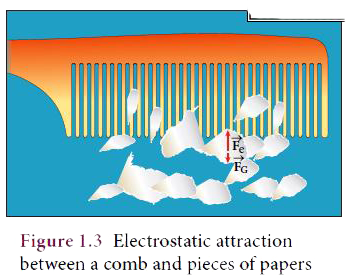Calculate the electrostatic force and gravitational force between the proton and the electron in a hydrogen atom. They are separated by a distance of 5.3×10−11 m. The magnitude of charges on the electron and proton are 1.6×10−19C. Mass of the electron is me=9.1×10−31 kg and mass of proton is mp=1.6×10−27 kg.
The proton and the electron attract each other. The magnitude of the electrostatic force between these two particles is given by
Fe=ke2r2=9×109×(1.6×10−19)2(5.3×10−11)2
=9×2.5628.09×10−7=8.2×10−8 N
The gravitational force between the proton and the electron is attractive. The magnitude of the gravitational force between these particles is
FG=Gmempr2
=6.67×10−11×9.1×10−31×1.6×10−27(5.3×10−11)2
=97.1128.09×10−47=3.4×10−47N
The ratio of the two forces FeFG=8.2×10−83.4×10−47
=2.41×1039
Note that
Fe≈1039FG
The electrostatic force between a proton and an electron is enormously greater than the gravitational force between them. Thus the gravitational force is negligible when compared with the electrostatic force in many situations such as for small size objects and in the atomic domain. This is the reason why a charged comb attracts an uncharged piece of paper with greater force even though the piece of paper is attracted downward by the Earth. This is shown in Figure 1.3

Topper's Solved these Questions
- ELECTROSTATICSBOOK - NCERT TAMILCHAPTER - ELECTROSTATICSEXERCISE - EVALUATION (Multiple choice questions)
15 Videos
- ELECTROSTATICSBOOK - NCERT TAMILCHAPTER - ELECTROSTATICSEXERCISE - Exercises
23 Videos
- ELECTROSTATIC POTENTIAL AND CAPACITANCE BOOK - NCERT TAMILCHAPTER - ELECTROSTATIC POTENTIAL AND CAPACITANCE EXERCISE - ADDITIONAL EXERCISES
1 Video
- MAGNETISM AND MAGNETIC EFFECTS OF ELECTRIC CURRENTBOOK - NCERT TAMILCHAPTER - MAGNETISM AND MAGNETIC EFFECTS OF ELECTRIC CURRENTEXERCISE - EVALUATION (IV. Numerical problems)
10 Videos
Similar Questions
Given the following data, calculate the electrostatic force and gravitational force between two electrons. Show that the electrostatic force is much greater than gravitational force, for the electrons separated by a certain distance.
Charge on the electron =1.6×10−19C
Mass of the electron =9.1×10−31kg
Gravitational constant =6.67×10−11Nm2kg−2
View SolutionThe ratio of electrostatic and gravitational force acting between electron and proton separated by a distance 5×10−11m, will be (charge on electron =1.6×10−19C, mass of electron =9.1×10−31kg, mass of proton =1.6×10−27kg,G=6.7×10−11N−m2/kg2)
View Solution
Knowledge Check
The ratio of electrostatic and gravitational force acting between electron and proton separated by a distance 5×10−11m, will be (charge on electron =1.6×10−19C, mass of electron =9.1×10−31kg, mass of proton =1.6×10−27kg,G=6.7×10−11N−m2/kg2)
A2.36×1039B2.36×1040C2.34×1041D2.34×1042
Calculate the equivalent energy of electrons and proton at rest. Given that mass of electron =9.1×10−31kg and mass of proton =1.673×10−27kg.
View SolutionCalculate the electrostatic force of attraction between a proton and an electron in a hydrogen atom. If the radius of the electron orbit is 0.05 nm and charge on the electron is 1.6×10−19C.
View SolutionThe speed of the electron in the hydrogen atom is approximately 2.2×106m/s. What is the centripetal force acting on the electron ifthe radius of the circular orbit is 0.53×10−10m?Mass of the electron is 9.1×10−31kg
View SolutionWhen would the wavelength associated with an electron become equal to that with proton ? (Mass of electron =9.10×10−31kg, Mass of proton =1.6725×10−27kg)
View SolutionWhen would the be Broglie wavelength of a moving electron become equal to that of a moving proton? Mass of electron =9.1095×10−31kg and mass of proton = 1.6725×10−27kg
View SolutionWhat is the uncertainty in velocity of an electron if the uncertainty in its position is 10−10m? Mass of the electron is 9.1×10−31kgandh=6.6×10−34m2s−1?
View SolutionWhat is the uncertainty in velocity of an electron if the uncertainty in its position is 10−10m? Mass of the electron is 9.1×10−31kgandh=6.6×10−34m2s−1?
View Solution
